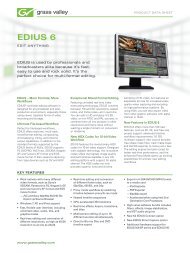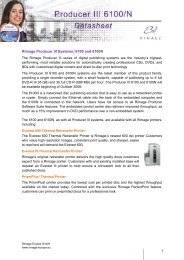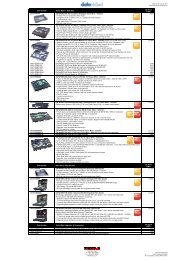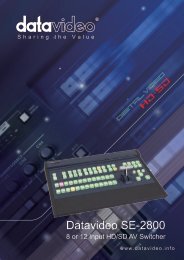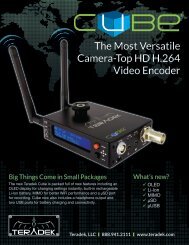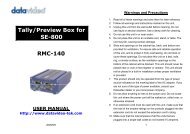Manual - Holdan.eu
Manual - Holdan.eu
Manual - Holdan.eu
You also want an ePaper? Increase the reach of your titles
YUMPU automatically turns print PDFs into web optimized ePapers that Google loves.
This menu item selects the desired Audio input for use with the active video<br />
source, allowing an audio-follow-video function. This is only functional for<br />
certain units with built-in audio switching, or when used with an optional Audio<br />
Switcher (not all units support this function).<br />
In most situations, the Audio input values would be different for each video<br />
source – so that when the first video source is selected, so is the first audio<br />
source (this is called ‘audio follow video’). The second video source then<br />
selects the second audio source, etc. However, there is nothing to prevent all<br />
Audio input values being set to the same value, for ‘audio breakaway’.<br />
Source: RGB1<br />
Audio Vol [ 1] Bal [ 0]<br />
This menu item adjusts the audio volume and balance for the selected audio<br />
channel. This is only functional for certain units when an optional Audio<br />
Switcher is attached.<br />
Source: RGB1<br />
On source loss<br />
(This has replaced ‘De-glitch’ used on previous firmware versions.)<br />
This option is used to tell the unit what to do if the video source is lost or<br />
becomes unstable. Options are:<br />
Option Description<br />
Show Shows all picture break-up and instabilities.<br />
Freeze Freezes the latest frame – un-freezes as soon as the<br />
source becomes stable again.<br />
Blue (default) Turns the window blue, to represent source loss.<br />
Black<br />
Remove<br />
[Blue]<br />
Turns the window black.<br />
Removes the window, thus showing any background<br />
(e.g. a Lock source). This is useful for MIX & PIP<br />
scenarios on units with overlay abilities.<br />
If you have a very unstable input, such as a video tape player with a poor<br />
(jumping) output signal, you may wish to turn the setting to ‘Show’.<br />
Source: RGB1<br />
Input pixel phase [ 16]<br />
Since an image pixel is a very small element of the total image, it’s possible<br />
for your unit’s Analog to Digital converters to wrongly sample the picture on<br />
the edge of each pixel thereby losing image resolution and creating image<br />
noise. The Input pixel phase adjustment allows you to change the position<br />
(from 0 to 31) where the pixels are sampled, relative to the horizontal sync<br />
signal.<br />
To make this adjustment, select an RGB source and then provide an image<br />
from that source with fine detail, preferably with very sharp vertical lines.




